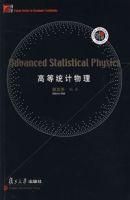內容簡介
本課程在大學本科物理專業熱力學統計物理及量子力學的基礎上,使用量子力學的語言,講述量子統計物理的基本原理及其套用。
內容提要
Statisticalphysicsestablishesabridgefromthemacroscopicworldtostudythemicroscopicworld.Thisisatheorywiththefewestassumptionsandthebroadestconclusions.Uptonowthereisnoevidencetoshowthatstatisticalphysicsitselfisresponsibleforanymistakes.Statisticalphysicshasbecomeanimportantbranchofmoderntheoreticalphysicsandthiscoursehasbecomeoneofthecommonfundamentalcoursesofgraduatestudentsindifferentmajorsinphysicsdepartments.Statisticalphysicsisabranchofscienceengagedinstudyingthelawsofthermalmotionofmacroscopicsystems.Theadvancedstatisticsforgraduatestudentsmainlystudiesquantumstatistics.Thefirstfourchaptersofthisbookarefundamental,andshouldbewellknown.Thelastfivechaptersarerecentdevelopments,includingthestudiesonBose-Einsteincondensation,aclassofinverseproblemsinquantumstatistics(theirChen'sexactsolutionformulas,Dai'sexactsolutionformulas,asymptoticbehaviorcontroltheory,andconcreterealizationsoftheinversiontheories),anintroductiontothetheoryofGreen'sfunctionsinquantumstatistics,theunifieddiagonalizationtheoremforHamiltoniansofquadraticform,andanintroductiontothethirdformulationofquantumstatisticsandthefunctionalintegralapproach.Thiscoursewaseditedbyrevisingthelecturenotesoftheauthor,fromcoursesofquantumstatisticsandadvancedstatisticsforgraduatestudents,since1978.Atthesametime,thisworkcontainstheresearchresultsofsomerelatedprojects,supportedbytheNationalNaturalScienceFoundationofChina.
作者簡介
戴顯熹,1938年5月生於溫州。1961年7月畢業於復旦大學物理系。1985年起任復旦大學物理系教授,1986年起任博士生導師。長期從事量子統計和理論物理方法研究,發表學術論文100多篇。
自1978年以來,從事研究生的量子統計與高等統計課程教學,以及本科生的電動力學、量子力學、數理方法、超導物理、理論物理方法等課程的教學。曾獲得楊振寧教授授予的GloriousSun獎金,曾以物理學中奇性問題研究獲教育部授予的科學進步獎(二等)等。1980年來應邀訪問過美國的休斯頓大學、紐約州立大學理論物理(楊振寧)研究所、德克薩斯超導中心、楊伯翰大學等,曾任楊伯翰大學客座教授。在量子統計、物理學中奇性問題、一些逆問題的嚴格解及其統一理論和漸近行為控制理論等方面作過較為系統的研究,首次由一材料的比熱實際數據中反演出聲子譜。
目錄
Chapter1FundamentalPrinciples
1.1Introduction:TheCharactersofThermodynamicsandStatisticalPhysicsandTheirRelationship
1.2BasicThermodynamicIdentities
1.3FundamentalPrinciplesandConclusionsofClassicalStatistics
1.3.1MicroscopicandMacroscopicDescriptions,StatisticalDistributionFunctions
1.3.2LiouvilleTheorem
1.3.3StatisticalIndependence
1.3.4MicroscopicalCanonical,CanonicalandGrandCanonicalEnsembles
1.4BoltzmannGas
1.5DensityMatrix
1.5.1DensityMatrix
1.5.2SomeGeneralPropertiesoftheDensityMatrix
1.6LiouvilleTheoreminQuantumStatistics
1.7CanonicalEnsemble
1.8GrandCanonicalEnsemble
1.8.1FundamentalExpressionoftheGrandCanonicalEnsemble
1.8.2DerivationoftheFundamentalThermodynamicIdentity
1.9ProbabilityDistributionandSlaterSum
1.9.1MeaningoftheDiagonalElementsoftheDensityMatrix
1.9.2SlaterSummation
1.9.3Example:ProbabilityoftheHarmonicEnsemble
1.10TheoryoftheReducedDensityMatrix
Chapter2ThePerfectGasinQuantumStatistics
2.1IndistinguishabilityPrincipleforIdenticalParticles
2.2BoseDistributionandFermiDistribution
2.2.1PerfectGasesinQuantumStatistics
2.2.2BoseDistribution
2.2.3FermiDistribution
2.2.4ComparisonofThreeDistributions;GibbsParadoxAgain
2.3DensityofStates,ChemicalPotentialandEquationofState
2.3.1DensityofStates
2.3.2VirialEquationforQuantumIdealGases
2.4Black-bodyRadiation
2.4.1ThermodynamicQuantitiesfortheBlack-bodyRadiationField
2.4.2ExitanceandVarietyofDisplacementLaws
2.4.3WavebandRadiantExitanceandWavebandPhotonExitance
2.5Bose-EinsteinCondensationinBulk
2.5.1BoseCondensation,DynamicalQuantitieswithTemperatureLowerThantheλPoint
2.5.2DiscontinuityoftheDerivativesofSpecificHeatandλPhenomena
2.5.3Two-FluidTheory
2.5.42-DCase
2.6DegenerateFermiGasesandFermSphere
2.6.1PropertiesofFermiGasesatAbsoluteZero
2.6.2SpecificHeatofFreeElectronGases
2.6.3StateEquation,HeatCapacityatConstantPressure,andHeavyFermions
2.7FermiIntegralsandtheirLowTemperatureExpansion
2.8MagnetismofFermiGases
2.8.1SpinMagnetism:Paramagnetism
2.8.2EnergySpectraandStationaryStatesofElectronsinaHomogeneousMagneticField
2.8.3DiamagnetismofOrbitalMotionofFreeElectrons
2.9PeierlsPerturbationExpansionofFreeEnergy
2.9.1ClassicalCase
2.9.2QuantumCase
2.9.3ExpansionofFreeEnergyofanIdealGasinanExternalField
2.10Appendix
Chapter3SecondQuantizationandModelHamiltonians
3.1NecessityofSecondQuantization
3.2SecondQuantizationforBoseSystem
3.3SecondQuantization·FermiSystem
3.4SomeConservationLaws
3.5SomeModelHamiltonians
3.6ElectronGaseswithCoulombInteraction
3.6.1CompletelyIonizedGases—theHighTemperaturePlasma
3.6.2TheDegenerateElectronGaswithCoulombInteraction(MetalPlasma)
3.7AndersonModel
Chapter4LeastActionPrinciple,FieldQuantizationandtheElectron-PhononSystem 4.1ClassicalDescriptionofLatticeVibrations
4.2ContinuousMediaModelofLatticeVibration(Classical)
4.3TheLeastActionPrinciple,Euler-LagrangeEquationandHamiltonEquation
4.4LagrangianandHamiltonianofContinuousMedia
4.5QuantizationoftheLatticeVibrationField
4.6DebyeTheoryofSpecificHeatofSolids
4.7TheElectron-PhononSystemandtheFrohlichHamiltonian
Chapter5Bose-EinsteinCondensation
5.1SpatialandMomentumDistributionsofBose-EinsteinCondensationinHarmonicTrapsandBlochSummation
5.1.1Introduction
5.1.2GeneralizedExpressionforParticleDensity
5.1.3DistributionsforIdealSystems
5.1.4NewExpressionwithClearPhysicalPicture
5.1.5MomentumDistributions
5.1.6ResultsofNumericalCalculations
5.1.7DiscussionandConcludingRemarks
5.1.8MomentumDistributionofBEC
5.2BECinConfinedGeometryandThermodynamicMapping
5.2.1Introduction
5.2.2ConfinementEffects
5.2.3ThermodynamicMapping
5.2.4MappingRelationforConfinedBEC
5.2.5DeterminationoftheCriticalTemperature
5.2.6Discussion
Chapter6SomeInverseProblemsinQuantumStatistics
6.1Introduction
6.2SpecificHeat-PhononSpectrumInversion
6.2.1TechniqueforEliminatingDivergences
6.2.2UniqueExistenceTheoremandExactSPIESolution
6.2.3Summary
6.3ConcreteRealizationofInversion
6.3.1TheSpecificHeat-PhononSpectrumInversionProblem
6.3.2ResultsandConcludingRemarks
6.4MobiusInversionFormula
6.4.1RiemannζFunctionandMobiusFunction
6.4.2MobiusInversionFormula
6.4.3TheModifiedMobiusInversionFormula
6.4.4ApplicationsinPhysics
6.5UnificationoftheTheories
6.5.1Introduction
6.5.2DerivingChen'sFormulafromDai'sExactSolution
6.5.3ConcludingRemarks
6.6Appendix
Chapter7AnIntroductiontoTheoryofGreen'sFunctions
7.1Temperature-TimeGreen'sFunctions
7.1.1DefinitionofTemperature-TimeGreen'sFunctions
7.1.2TheEquationofMotionofDouble-TimeGreen'sFunctions
7.1.3TimeCorrelationFunctions
7.2SpectralTheorem
7.2.1SpectralRepresentationofTimeCorrelationFunctions
7.2.2SpectralRepresentationsofRetardedandAdvancedGreen'sFunctions
7.2.3SpectralRepresentationofCausalGreen'sFunctions
7.3Example:IdealQuantumGases
7.4TheoryofSuperconductivitywithDouble-TimeGreen'sFunctions
7.5Higher-OrderSpectralTheorem,SumRulesandUniqueness
Chapter8AUnifiedDiagonalizationTheoremforQuadraticHamiltonian
8.1AModelHamiltonian
8.2DiagonalizationTheoremforFermiQuadraticForms
8.3Conclusion:AUnifiedDiagonalizationTheorem
Chapter9FunctionalIntegralApproach:AThirdFormulationofQuantumStatisticalMechanics
9.1Introduction
9.1.1Hubbard'sMethod
9.1.2Difficulties
9.2AnOperatorIdentity
9.3FunctionalIntegralFormulationofQuantumStatisticalMechanics
9.4RealityandMethodofSteepestDescents
9.5DiscussionandConcludingRemarks
9.6SomeRecentDevelopments
9.7Application:AnExactSolution
References
Index

